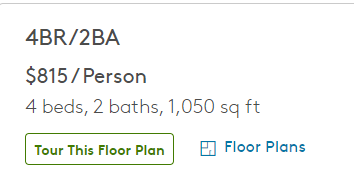Heading to college? Brace yourself for a slew of multiple-choice questions! Here's a taste: Where do you see yourself living - (a) a dorm, (b) a student apartment, or (c) a traditional apartment? And what exactly is a student apartment, you ask?
Student apartments are off-campus apartments that typically aren’t affiliated with any university or college. These apartments are located around universities and are most often rented by the bedroom rather than as an entire apartment. As a result, there are often several students sharing the apartment, each with their own bedroom but with shared common spaces such as the kitchen, living room, and potentially bathroom, depending on whether or not the apartment has a private bathroom for everyone.
As you begin your student apartment search, you might have some questions of your own. For example:
- How are student apartments different from regular apartments?
- Will my credit be checked?
- Will I need a cosigner for a student apartment?
- Do student apartments only rent to students, or can anyone live there?
- Can I use financial aid to pay my rent?
- Is there an option to choose your own roommates?
- How is a student apartment different from an on-campus dorm?
You want a great place to live, but you also want one that’s appealing, economical, and practical. After all, you’re looking for your home away from home, so you need answers to all your questions. This guide will help you find a fabulous place to live so you can start your college years off right — or at least in the right apartment.
Different Types of Student Housing
You’ll come across a variety of options during your apartment search, and some of the terms could be new to you. Here are some of the most common types of rentals for students and how they compare:
|
Feature |
Student Apartments |
Dorms/On Campus Housing |
Traditional Apartments |
|
By-the-bed pricing |
✔ |
|
|
|
Shared space with others |
✔ |
✔ |
|
|
Room and board included |
|
✔ |
|
|
Furnished |
✔ |
✔ |
|
|
Flexible leasing options/rent by the semester |
✔ |
✔ |
|
|
Private |
|
|
✔ |
|
Cost-effective |
✔ |
|
✔ |
|
Strict rules and curfews |
|
✔ |
|
|
Has amenities and features |
✔ |
|
✔ |
|
Complete floor plan with private living room/kitchen |
|
|
✔ |
|
Requires a security deposit/move-in fees |
✔ |
|
✔ |
Student housing
Student housing is priced per person per bedroom. The apartment may have anywhere from two to six bedrooms, and each bedroom is rented out within the apartment. If you are searching for your student apartment on Apartments.com, the apartments that offer by-the-person pricing will look like this:

Typically, the more bedrooms available, the less the cost will be for each person. So, for example, a two-bedroom student apartment may offer each bedroom for $850. An apartment with four bedrooms might rent for $425 per person. Sometimes, each bedroom is equipped with a private bathroom, while sometimes, two or more bedrooms will share a bathroom. The residents will always share the kitchen and living areas. These apartments are typically furnished and are often equipped with amenities like in-unit washers and dryers, and some even allow pets. You may find student housing that includes utilities and even Wi-Fi in the rent price.
Unlike on-campus dorms, you won’t have strict rules or a curfew to follow. You will have a lease, however, which will have some rules you’ll have to abide by or risk eviction. These apartments are larger than a standard dorm, so you’ll have more privacy. Dorms typically limit what you can have in your dorm room, but you’ll have more freedom with what you can add to your student apartment (for example, coffee makers are banned from some dorms).
While both dorms and student apartments come furnished, there’s a difference between most dorm furnishings and those in student apartments. Dorms are typically sparse with the furnishings, so you’ll have a bed, a dresser, and maybe a desk and chair. The furniture is functional and sturdy, but not necessarily attractive. On the other hand, student apartments are typically furnished with stylish décor that includes artwork and nice finishes (for example, granite countertops in the kitchen or a couch in the living room).
You might hear student apartment communities referred to as PBHs, or Purpose-Built Housing communities. This term is increasing in popularity as apartment buildings are being built specifically with students in mind. They are usually privately owned and not affiliated with the university they serve, but they are located very close to the university — often withing walking or biking distance. Many offer high-end community amenities like a swimming pool, on-site fitness center, study rooms, and on-site print shops. The apartments may provide in-unit washers and dryers, fully equipped kitchens, and even flat-screen televisions. These communities often offer roommate-matching programs, so if you don’t have specific friends you want to room with, the roommates you end up with will likely have similar interests and traits as you.
While there’s no law stating that a non-student can’t rent in a PBH community, you’ll find that most of the residents are students. This is because the leases are short to accommodate student schedules. Student apartments are designed to be temporary, with leases that correspond with the university calendar. They aren’t designed for longevity, so they don’t often attract long-term renters. PBH communities are very student-centric, with some offering programs designed for students and even shuttle buses to and from campus.
On-campus college dorms
Traditionally, on-campus housing is more expensive than off-campus housing. That said, on-campus housing will include utilities, so you won’t have to worry about things like electricity and water bills. Most dorm rates include some sort of meal plan, as well. Dorms are less private than off-campus housing. For example, instead of your own bedroom (or apartment) with a bathroom, a dorm will have one bathroom for the floor to share, or it will have one bathroom for a couple of roommates or suitemates to share. If you enjoy organized activities, living in a college dorm will provide you with access to a variety of scheduled events. And, unlike off-campus housing, all of the dorm residents are students.
Living on campus, you’ll have to follow rules and regulations, and depending on the university, some of these can be strict. You might be required to live on-campus your first year unless you are able to get an exemption or waiver. The university should specify who qualifies and how to obtain a waiver. You’ll have a house leader or resident adviser who might conduct dorm inspections to make sure you aren’t violating any of the rules. Dorms often impose curfews and might limit how many guests you can have, and most dorms don’t allow pets. Items that are often banned from dorms include things you might not expect, such as houseplants and extension cords. You may not get a choice of roommate in a dorm. For example, if a bed is empty, the university could move someone in at any time.
Since dorms are located on campus, you will be able to walk or bike quickly to class, and you probably won’t need a car. But if you do want your car, most college dorms have parking areas where you can pay an additional fee to park your car there for the school year. If you live off campus, you’ll have to commute a bit, either by car, bus, or bike, and you may have a more difficult time with parking.
Off-campus apartments
If you want to live alone (or choose your own roommate) and you don’t mind a short commute to campus, then you might prefer a traditional apartment. While you’ll be fully independent, living in your own apartment will also have some challenges. For example, you’ll have to pass a background and credit check when you apply for an apartment. If you don’t have any credit, you might need a cosigner or guarantor to sign the lease. Unlike student apartments, which follow the school calendar, you might have to sign a traditional lease, which is often 12 months long. Unless you find a furnished apartment, you’ll have to bring or purchase furniture and other necessities like cookware, cleaning supplies, and small appliances.
The best thing about living off campus is the privacy. You’ll also likely have amenities and features in your apartment, like a balcony or patio and walk-in closets, that you can’t get in a dorm. It’s typically less expensive than dorm living, but you will have to buy your own food. You’ll have a lot more space, and it will be quieter than sharing a dorm or a student apartment.
How to Qualify for an Apartment as a Student
Property managers at student apartments are aware that most students don’t have established credit, so you might find it easier to rent a student apartment than a traditional apartment. In either case, you could need a cosigner. When meeting with a property manager about any off-campus apartment, they usually want to know how you intend to pay the rent. Since you are a student, most student apartment communities are aware that you likely won’t be paying directly — the rent will be paid by your parents or through financial aid.
Take along some personal references to show the property manager that you’re reliable. You might be required to have a cosigner or guarantor.
If you are renting a traditional apartment, you will likely need proof of income, so bring along pay stubs or bank statements. You’ll also want to bring references, and you’ll probably need a cosigner for a traditional apartment if you don’t have an established credit or rental history. If you have rented before, ask your former landlord for a reference letter.
Can Student Loans Be Used for Apartment Rent?
Yes, and it is very common for students to pay for off-campus student housing with financial aid. But there are risks involved. If you use student loans to pay your rent, you are incurring a lot of debt that you’ll eventually have to pay back. Also, there could be a delay with disbursement, which could cause your rent to be late.
The university will take the funds necessary to cover your tuition and school-related fees. The school won’t release the rest of the funds for your personal use (such as paying rent) until your tuition and fees are paid. Keep that in mind if you are intending to pay rent with your student loan money.
Is Off-Campus Housing Cheaper?
It can be cheaper to live off-campus, but it depends. Most universities include room and board for dorms, so you don’t have to purchase food. However, the meal plan that is often required for students may be quite expensive. Universities don’t charge you for utilities like electricity and water. But the costs are uniform for everyone, meaning you’ll pay for these things even if you don’t use them.
Off-campus housing allows a little more flexibility in how much you spend on things like food and utilities. However, off-campus apartments will require more to move in, such as a security deposit, move-in fees, and deposits for utilities. If you choose to rent an apartment, consider finding a roommate to help share these costs.
Additional Tips for Finding a Fabulous Student Apartment
While understanding the differences between the various student housing options is essential, there are several additional factors to consider when searching for your perfect student apartment. Here are some extra tips to help you navigate your search process effectively:
1. Begin your search early: Begin your apartment search well in advance of your desired move-in date. Popular student apartments can fill up quickly, especially in college towns, so starting early will give you more options to choose from and increase your chances of securing your preferred location and amenities.
2. Set a budget: Determine how much you can afford to spend on rent, utilities, and other expenses related to apartment living. Consider not only the monthly rent but also additional costs such as security deposits, application fees, and potential utility bills. Be realistic about your budget and prioritize your must-have features when evaluating different apartments.
3. Research different neighborhoods: Explore different neighborhoods surrounding your college campus to find the area that best suits your lifestyle and preferences. Consider factors such as proximity to campus, public transportation options, safety, amenities, and local attractions. Visiting neighborhoods in person and talking to current residents can provide valuable insights into what it's like to live there.
4. Tour apartments: Schedule tours of potential apartments to see them in person and evaluate their condition, layout, and amenities. Pay attention to details such as cleanliness, maintenance, and the overall atmosphere of the community. Don't hesitate to ask questions about leasing terms, policies, and any concerns you may have during the tour.
5. Consider roommate compatibility: If you're planning to share your student apartment with roommates, carefully consider compatibility factors such as lifestyle preferences, cleanliness habits, study habits, and communication styles. Discuss expectations, responsibilities, and potential conflicts upfront to ensure a harmonious living environment.
6. Review the lease agreements: Before signing a lease agreement, carefully read all terms and conditions, including rent amount, lease duration, pet policies, maintenance responsibilities, and any additional fees or restrictions. Ensure that you understand your rights and obligations as a tenant and seek clarification on any ambiguous clauses or concerns.
7. Plan for moving in: Once you've selected your student apartment, start planning for the move-in process. Create a checklist of tasks such as packing, arranging transportation, transferring utilities, and notifying relevant parties of your change of address. Consider enlisting the help of friends or family members to make the move smoother and less stressful.
8. Get involved in the community: Embrace the opportunity to become part of your apartment community by attending resident events, participating in group activities, and getting to know your neighbors. Building connections with fellow residents can enhance your college experience and create a sense of belonging in your new home away from home.
By following these additional tips and considerations, you'll be well-equipped to find a fabulous student apartment that meets your needs, preferences, and budget. Whether you choose a student apartment, a dorm, or a traditional apartment, be sure to ask lots of questions. Read your lease agreement carefully and start your apartment search as early as possible. Luckily, unlike a traditional multiple-choice question, there are no wrong answers here! Just choose the option that works best for you. Happy apartment hunting!






